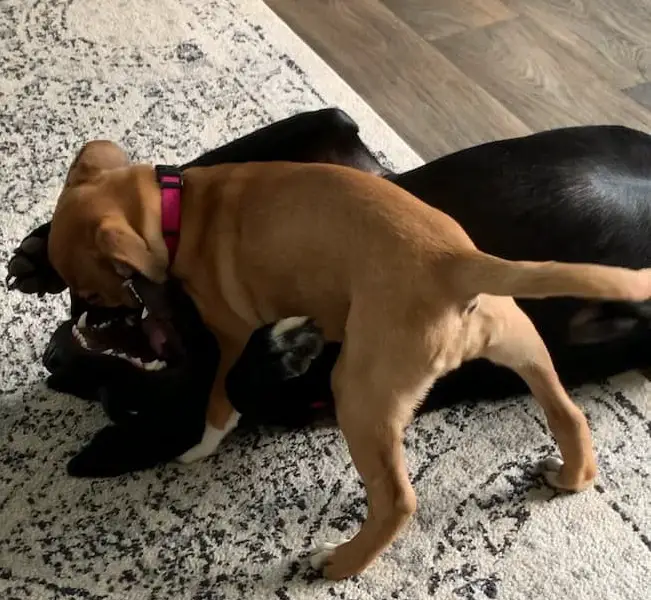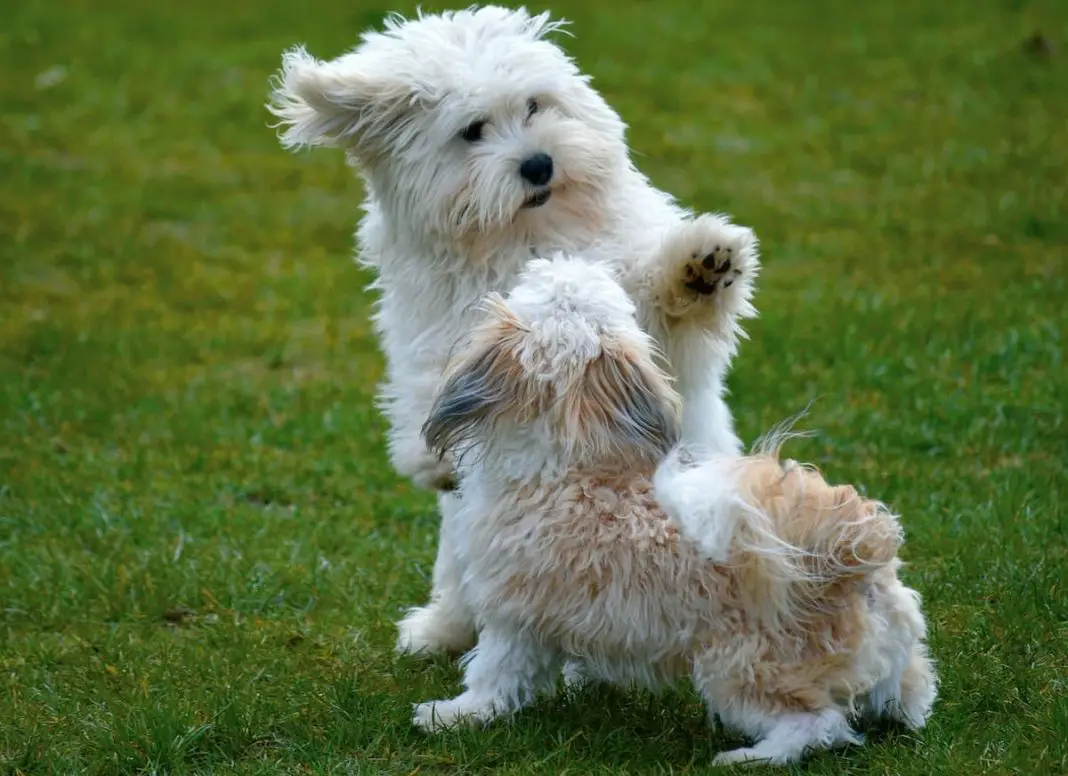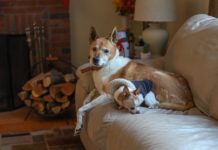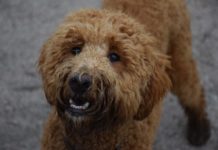If you have a big puppy that’s playing too rough with your other small dog, then this could be causing frequent friction between the two dogs. One of the best ways for a puppy to learn the ropes is by modelling the behaviors of older dogs, although it can be challenging if the older dog is smaller.
Big Puppy Too Rough With Small Dog
Types of mock-fighting and roughhousing are generally good for puppies as it teaches them several things that can be useful later in life. The instinct for an older dog to play fight with puppies is deeply embedded in their DNA from the days when they were wild. However, sometimes this form of play can become dangerous for either the puppy or the smaller dog that is playing, as either two can quickly become overly excited.

Is It Playtime Or Time To Separate?
It’s normal for puppies and dogs of any size to growl and romp over one another in a mock battle. Although dogs displaying this behavior can seem a little aggressive to us, but as long as they are within the boundaries of good fun, it’s usually okay (and can help them with socialization skills).
What’s Causing Your Puppy To Play Rough?
There can be a number of reasons why your puppy is consistently playing too rough. First, it’s common for young puppies to turn to roughhousing as they can’t quite control their emotions. It doesn’t take a puppy long to get excited and overstimulated, especially when they’re around a smaller dog. They can’t help but get out of control. In most cases, a young puppy will grow out of this phase as it learns better impulse control.
Another reason why a puppy plays rough is that they were accidentally taught to do it that way. It’s normal for older dogs to play rough with puppies to show them who’s boss, resulting in a puppy overdoing it. Most owners are also to blame for this misguided life lesson. Have you ever wrestled with your puppy on the living room floor? While play wrestling is fun, it teaches a puppy to take that style of play like that with other dogs, regardless of their size.
Another possibility is your puppy plays too rough because it’s trying to dominate the other smaller dog. In this situation, they’re not actually playing. It’s more of a minor aggression that won’t lead to anything good. You’ll need to decipher why your larger puppy feels the need to dominate your smaller dog and address that specific issue before you can expect them to start playing nice.
Teaching Your Puppy To Play Better With Smaller Dogs
In a perfect situation, your puppy should play with a puppy that’s of a similar age, as puppies teach each other what works in play and what doesn’t. When something hurts, they yelp. When a fellow puppy does something that they don’t like, they let them know, whereas the dog may end up snapping at the puppy. This kind of trial and error is important for puppies to figure out how to properly interact with others. Don’t worry if your puppy is already past this point, as there are still ways to teach older puppies how to play nicely with others.
Having a good foundation of obedience will be the difference between constantly splitting your bigger puppy from your smaller dog. You won’t directly address the issue with playing at first, but obedience is an invaluable part of the process. Before letting your puppy loose with another dog, you need to be confident in their training first.
Will your puppy remember its recall when it’s distracted, playing with the other dog? Will it still listen to you when all it wants to do is tackle your small dog? If the answer is no, then it’s time to take a break from your puppy playing with the other dog while you focus on reinforcing obedience. You’ll have an easier time guiding your puppy towards more appropriate play when you can easily communicate.
When your puppy starts to play with the other dog, it’s your job to closely observe what’s happening. It’s important to stop rough play before it actually happens. To do this, you need to be able to understand your puppy’s body language. Once you see your puppy getting overly excited or aggressive, that’s your cue to step in and calm them down.
Don’t Encourage Bad Behavior
If you let your puppy continue to play rough, you’ll make it think that it’s okay. So, stopping things before they get out of control is important.
If you know that your puppy starts to get extra excited when being left alone in the same room as the other dog, then make sure that both aren’t alone together for long periods of time, or while either of them is excited.
Teaching The “Settle” Cue
Besides teaching a puppy to sit, stay, and come, one of the best cues you can teach your puppy is to settle. When your puppy starts to get too excited when playing and they hear the word “settle” it should tell them that it’s time to calm down.
This should be taught to your puppy in a no-distraction zone. Say the word “settle” while using a treat to lure your puppy where you want it to be. This can be either on their mat or in a sit or down position. Once they’re consistently following your lure, make it wait calmly for a few seconds before giving out the reward. If the puppy is anything less than perfectly calm, it’s time to start over.
With practice, as time goes on, you can add distractions to the routine. Try taking the puppy into the yard or garden, then the sidewalk, and finally a large area where the puppy and other dog are together. These changes will only be gradual and only when the puppy is consistently listening to you at the previous stage. With time, your goal is to be able to get your puppy’s attention no matter what’s happening around them and have them calm down on cue.








